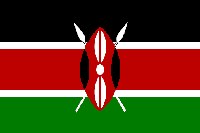
Kenya
Stats & Facts Physical Economy History

Kenya is an equatorial country in east Africa, bounded inland by Somalia on the east, Ethiopia and Sudan on the north, Uganda on the west, and Tanzania on the south.
Statistics & Facts
Capital : Nairobi
Area : 582,646 km2 (224,961 sq. mi.)
Population : 28.626 million (1995)
Currency : 1 Kenya shilling = 100 cents
Religions : Protestant 26.5%; Roman Catholic 26.4%; traditional beliefs 18.9%; African Indigenous 17.6%; Muslim 6.0%; Orthodox 2.5%
Ethnicity : Kikuyu 20.9%; Luhya 13.8%; Luo 12.8%; Kamba 11.3%; Kalenjin 10.8%; other African 29.2%; other including Asian 1.2%
Languages : Swahili (official); English; local languages
International Organizations : Non-Aligned Movement; OAU; UN; Commonwealth
Physical
In the south-east of Kenya is a hot, damp coast on the Indian Ocean, into which run two
long rivers, the Tana and the Galana. They rise in the central highlands, a region
containing Mount Kenya and cool slopes and plateaux suitable for farming of various
kinds, particularly the cultivation of tea and coffee. The highlands are split by part
of the Great Rift Valley, a region of lakes, and to the west fall away to the eastern
shore of Lake Victoria. Northward is a rift-valley lake, Turkana (once called Rudolf),
and to its east is a vast, hot, dry region with thorny scrub. In the south there is a
smaller lake, Magadi, with major deposits of soda.
Economy
Kenya has an agricultural economy with a developing industrial sector. Main exports
are coffee, tea, and petroleum products (from imported crude oil) from the oil
refinery at Mombasa. Tourism is an important sector of the economy, while the
textiles, chemical, and vehicle-assembly industries are also significant. There
is a developed financial services sector, and a flourishing informal sector. Kenya
obtains some two-thirds of its electricity from hydroelectric dams. There are mineral
deposits of soda ash, fluorspar, salt, and gold. Agriculture is diverse: the highlands
produce maize, coffee, tea, and sisal, while lowland crops include coconuts, cashew
nuts, and cotton.
History
In areas of the Great Rift Valley, such as Lake Turkana, palaeontologists
have discovered some of the earliest fossil hominid remains. Arabs settled on the
coast during the 7th century. During the 16th and 17th centuries, Portuguese traders
operated in the region. The Masai pastoral people came into the area in the 18th
century from the north, but during the 19th century they were largely displaced
by the agricultural Kikuyu, who steadily advanced from the south. British coastal
trade began in the 1840s, and in 1887 the British East African Association (a
trading company) secured a lease of coastal strip from the Sultan of Zanzibar.
The British East Africa Protectorate was established in 1896, when thousands of
Indians were brought in to build railways. The British crown colony of Kenya was
created in 1920. By then a great area of the 'White Highlands' had been reserved
for white settlement, while 'Native Reserves' were established to separate the two
communities. During the 1920s there was considerable immigration from Britain, and
a development of African political movements, demanding a greater share in the
government of the country. Kikuyu nationalism developed steadily, led by Jomo
Kenyatta. From this tension grew the Kenya Africa Union, and the militant Mau Mau
movement (1952-7). An election in 1961 led to the two African political parties,
the Kenya African National Union (KANU) and the Kenya African Democratic Union (KADU),
joining the government. Independence was achieved in 1963, and in the following year
Kenya became a republic with Kenyatta as President. Under him, Kenya remained
generally stable, but after his death in 1978 opposition to his successor, Daniel
arap Moi, mounted, culminating in a bloody attempted coup in 1982. Elections in
1983 saw the return of comparative stability with Moi still President, but of an
increasingly corrupt and autocratic regime. In December 1991 Moi reluctantly agreed
to end single-party politics, as a result of pressure from the Forum for the
Restoration of Democracy (FORD), supported by Western aid-donor nations. Multi-party
elections, held in 1992, were won by Moi amid allegations of electoral fraud.
Sporadic outbreaks of ethnic and political violence have continued. In mid-1997
riots and protests occurred in Nairobi as the opposition demanded sweeping
constitutional change: a general election was set for December.